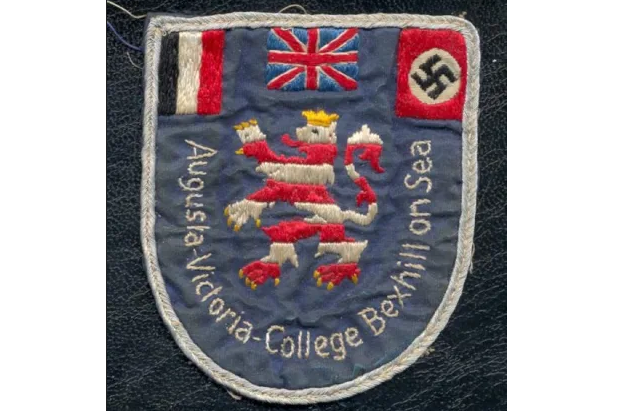
On 20 April 1939, the girls had a special treat in store. Dinner was much better than usual, and the headmistress ran up a large swastika flag. It was the Führer’s birthday, and the school celebrated in style. As well as the good dinner, there was a chance to sing some rousing Nazi songs.—Alan Starr, Secret Bexhill-on-Sea
When the British comedian Eddie Izzard visited the local museum in the town in which he was brought up, Bexhill, in the county of East Sussex, his attention was immediately drawn to a hand-embroidered azure, gules and white Augusta-Victoria College Bexhill-on-Sea school uniform crest, with a royal lion rampant, sporting golden crown and claws—and the British and Nazi flags side-by-side.
Not surprisingly, this was the only English school badge Izzard had ever seen that incorporated a swastika in its design. It became the inspiration that led him to create his first screenplay, Six Minutes to Midnight (2020), for a film in which he plays the lead role. The movie is directed by Andy Goddard. It is co-written by Goddard, Celyn Jones and Izzard and produced by Mad As Birds Films.
Six Minutes to Midnight tells the story, based on fact, of a British finishing school for the daughters and goddaughters of the Nazi elite, in the late 1930s, just before the outbreak of the Second World War.
Joe Dolce appears in every Quadrant.
Click here to subscribe
The story begins as Mr Wheatley, an English teacher at the Augusta-Victoria College for Girls, discovers that something valuable is missing from a locked box on his bookshelf. In a panic, he rides his bicycle to a public phone box to make a call. He insists that he can’t return to the school now—his small camera is missing—he has been “found out”.
It’s August 15, 1939, and a voice-over announces that Germany has just invaded Poland. A row of svelte Aryan-looking girls, hair in braids, walk single-file down to the Bexhill beach. They perform disciplined fitness exercises under the direction of Ilse Keller. Each girl is wearing a white singlet with a small black and red swastika on it.
A new English teacher, Thomas Miller (played by Izzard), arrives at the school to replace Mr Wheatley, who has disappeared. He is greeted by the governess, Miss Eleanor Rocholl (played by Judi Dench) and has been hired to complete an urgent student presentation to members of the Anglo-German Fellowship.
Rocholl asks him, “What sort of Englishman would accept a post teaching Herr Hitler’s League of German Girls?” Miller is actually an undercover British agent who has been sent to acquire information about Nazi collaborators 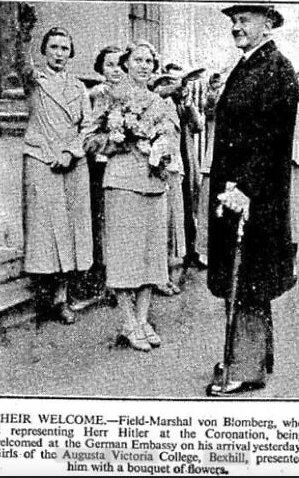 at the school. Many of the students are the daughters of the Nazi High Command sent to the British finishing school to learn deportment, to read and write English and to study Shakespeare.
at the school. Many of the students are the daughters of the Nazi High Command sent to the British finishing school to learn deportment, to read and write English and to study Shakespeare.
In his first class, Miller meets his wards. He is told that the previous teacher never used books, but only read aloud, so to break the ice, Miller leads them in a rousing version of “It’s a Long Way to Tipperary”.
The girls go for their morgenschwimmen (morning swim) and, while walking along the beach, one of the girls, Gretel, discovers the washed-up body of their previous English teacher. Later that night, Miller has a clandestine meeting with a British agent, Colonel Smith. Smith tells him that the British will soon take over the Augusta-Victoria College and the German girls will be held as prisoners of war.
Back at the school, Miller hears the booming voice of Adolf Hitler over the radio. The girls are listening in rapt attention and they stand, giving the Nazi salute, shouting “Sieg Heil!” Miss Rocholl calmly explains to a distressed-looking Miller that the salute only means “Hail to Victory”.
On the eve of the Anglo-German Fellowship presentation, Miller slips away to the governess’s office to photograph documents listing the names of Fellowship members. Keller meets with a Nazi minister, who instructs her, in German, that the girls must not fall into British hands and must be secretly evacuated the  following night by air. She must find a suitable landing place. The minister gives her a list of British agents working behind the lines in Germany.
following night by air. She must find a suitable landing place. The minister gives her a list of British agents working behind the lines in Germany.
That night, as Miller meets again with Colonel Smith in his car, a figure with a pistol approaches and fires three bullets through the windscreen, mortally wounding Smith. Before Smith dies, he instructs Miller to call Whitehall 1154 and raise the alarm. Miller picks up the gun but is seen by two policemen, who give chase, believing him to be the murderer. They catch him and, in custody, he is interviewed by two government agents, Captain Drey and Corporal Willis, who accuse him of murdering Smith and spying for Germany. Miller tells Drey to contact Whitehall, who will vouch for him, giving him the phone number 1154, which Drey recognises and comments, “Six minutes to midnight.”
Drey dials the number but tells Miller there is no reply. Miller tells Drey he has a list of Nazi conspirators working in England and they go to the school to get the list. Ilse Keller enters the room and Miller discovers that she and Drey are both working for the Nazis.
Drey gives Keller a pistol, ordering her to ensure that the children are not captured by the British, but Miller manages to overcome Drey and escape. Keller and her students leave to meet the plane. Miss Rocholl, unaware that Keller was a Nazi agent, stays behind.
Miller is once again captured by Drey and Willis, and just as he is about to convince Willis that his superior Drey is a Nazi agent, Drey shoots Willis. Drey, turning to shoot Miller, is killed instead by the wounded Willis.
Miller returns to the school, where Miss Rocholl alerts him to the only flat large field nearby that will accommodate an aircraft, and he tells Whitehall. In the field the girls have formed two lines and hold flares, making a runway visible in the dark for the Nazi pilot, but, as it attempts to land, it is driven away by Spitfires.
Keller, following her instructions, draws her pistol on the students, preparing to kill them, but wounds Miller, who steps between them. Gretel succeeds in reasoning with Keller to drop her pistol.
A decision is made that the girls will remain at the school, under Miss Rocholl’s care, “until a solution can be agreed”. As Miller departs for the War Office, the girls farewell him singing “It’s a Long Way to Tipperary”.
An announcement is heard over the radio that a state of war now exists between Britain and Germany.
Six Minutes to Midnight was directed and co-written by Andy Goddard, who has directed episodes of Downton Abbey and whose first film was Set Fire to the Stars (2014), a fine biopic about the Welsh poet Dylan Thomas. Celyn Jones, who also plays Corporal Willis, co-wrote the Six Minutes to Midnight script and was co-writer on Set Fire to the Stars, and played the lead role of Dylan Thomas.
Eddie Izzard spent much of his childhood in Bexhill-on-Sea. He was voted No. 3 of the 100 Greatest British National Comedians (Billy Connolly was No. 1) for his signature free-association and seemingly effortless style of stand-up. John Cleese called Izzard “the lost Python” and Izzard has credited Monty Python’s Flying Circus as 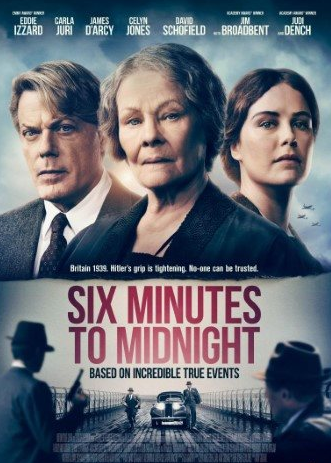 one of his strongest influences. He has appeared in films such as Shadow of the Vampire (2000), Valkyrie (2008), about the attempted assassination of Hitler by renegade German officers, and Victoria and Abdul (2017), as Bertie, Prince of Wales, with Judi Dench as the Queen.
one of his strongest influences. He has appeared in films such as Shadow of the Vampire (2000), Valkyrie (2008), about the attempted assassination of Hitler by renegade German officers, and Victoria and Abdul (2017), as Bertie, Prince of Wales, with Judi Dench as the Queen.
Six Minutes to Midnight has been advertised as “based on true events” but, other than the Augusta-Victoria College Bexhill-on-Sea, the unique school crest with the British flag and swastika side-by-side, and the fact that the college was indeed a finishing school for daughters of the Nazi High Command, the story is fictional.
The Augusta-Victoria school was founded in 1932 by Frau Helene Rocholl, a stately enthusiastic Nazi, and her assistant, Baroness von Korff. According to Julian Porter, curator of the Bexhill Museum:
[Von Korff] seems to have been a slightly softer personality and not so politically minded, she seems to have been involved in running the College on a day-to-day basis and Frau Rocholl was dealing with the management and enrolment of students … The Baroness was more interested in how aristocratic the girls were, rather than how Nazi they were.
The gentler character of Frau Rocholl, as portrayed in the movie by Judi Dench, is an amalgamation of both of these women.
There is sparse information about the school, even in Bexhill. Old newspaper articles indicate twenty-four students, aged between sixteen and twenty-one. Most of the school’s history comes from an English woman named Molly Hickie who worked there for four years. Part of her job was making sure the girls spoke English, not German. Hickie was engaged to a Nazi soldier named Frederick von Braunstrike and was in Germany visiting him when Britain declared war. When she arrived back at the school, all the girls were gone. She subsequently joined the Women’s Royal Naval Service and her fiancé was killed on the Russian front.
The opening sequence of the film, showing the girls exercising on the Bexhill beach, in white singlets decorated with the League of German Girls black and red swastika, was also a bit of artistic licence. The few known photographs of Augusta-Victoria students show them in conservative clothing, even at sport (below). When Izzard interviewed Hickie before she died several years ago, and asked her if anyone wore the swastika at the school, either on armbands or badges, she replied, “No, I don’t think so. No. They didn’t flaunt it … they had very nice blue blazers but with the crest on.”
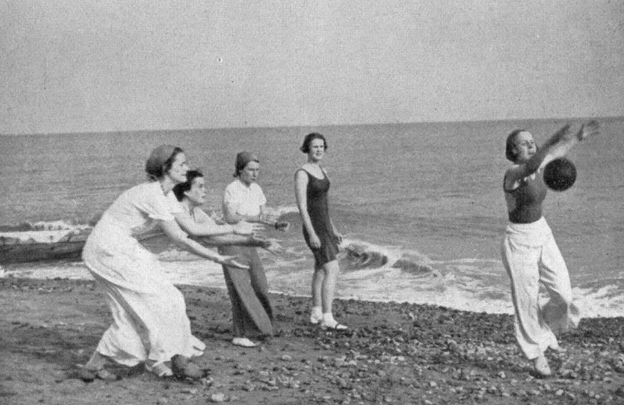
The uniform crest (reproduced atop this page) that first inspired Izzard at the Bexhill Museum is dated from 1933 and originally had three flags—the Nazi swastika in the upper right corner, the Union Jack in the centre and the imperial German flag to the left. When the Nazis took over Germany the patch was redesigned, with only the British and Nazi flags. This was the one used in the film.
Miller is told by his students that the previous English teacher never used books but only told them oral stories. This is impossible, as the school taught Shakespeare and focused on the Cambridge Certificate of Proficiency in English.
Ilse Keller is given a Luger and told under no circumstances are the young German women to fall into British hands, but it is unlikely that even the Nazi military and Prussian royal families would have sanctioned the killing of their own children at the very beginning of the war.
In May 1939, Frau Rocholl told the Bexhill-on-Sea Observer, “There is not going to be a war.” If the British detained the schoolgirls as prisoners of war, there is no mention of this in any records I can locate. It seems they had all gone back home to Germany by the end of August, before war was declared in September.
The governess of the school, Miss Rocholl, refers to the young women as “Hitler’s League of German Girls”. This was one of the most interesting themes left undeveloped in the film.
The well-known Hitler Youth, or Hitler-Jugend, was founded in 1926 as an off-shoot of the German Workers Party. In 1931, the Hitler Youth became the umbrella organisation for all the Nazi youth groups. Membership in the Hitler Youth was compulsory for all boys and girls over the age of ten.
Originating as a boys-only movement, a lesser-known division was established, for single women, in 1931, Bund Deutscher Mädel: The League of German Girls, which was the only legally permitted organisation for young women in Nazi Germany. There were three sections of the Bund Deutscher Mädel: the main branch for adults, the Jungmädel for girls from ten to fourteen; and much later, the Belief and Beauty Society (Glaube und Schönheit), voluntary for ages seventeen to twenty-one. To be eligible a girl had to be ethnic German and free of hereditary diseases. The uniform consisted of a full blue skirt, blouse, a triangular black neckerchief, a black beret, a short brown jacket called the Kletterjacke, and marching shoes.
Women in top leadership positions in the League were required to leave when they married and, especially, when they had children. Child-bearing was encouraged. If a single woman wanted to bear a child she had the option of going to the neighbourhood Lebensborn where she could be made pregnant by a racially-pure SS member. The Motherhood Cross was awarded to women who had given birth to the most Aryan-pure children. It was presented on Hitler’s mother’s birthday, August 12—bronze for mothers of four, silver for mothers of six and gold for mothers of eight or more.
When war broke out, the boys of the Hitler Youth were fed into the armed forces. Older girls served as nurses, searchlight operators and office staff. They took little part in actual fighting, although some operated anti-aircraft guns. Particularly strong and athletic girls were recruited into the Werwolf groups that were created towards the end of the war to wage guerrilla resistance in areas occupied by the Allies. Younger girls collected goods and donations for Nazi charities and winter relief, joined choirs and bands, and visited wounded soldiers in hospitals for morale building. Others grew gardens and knitted.
Seven per cent of the 55,000 Nazi concentration camp guards were women, known as the Aufseherinnen, mostly matrons, opera singers and retired teachers. Many SS men had relationships with female guards. Ilse Koch, known as the “Bitch of Buchenwald”, married the camp commandant, Karl Koch (the happy couple are pictured below). Koch was later executed by the Nazis for embezzling millions of Reichmarks and his wife was sentenced to life imprisonment.
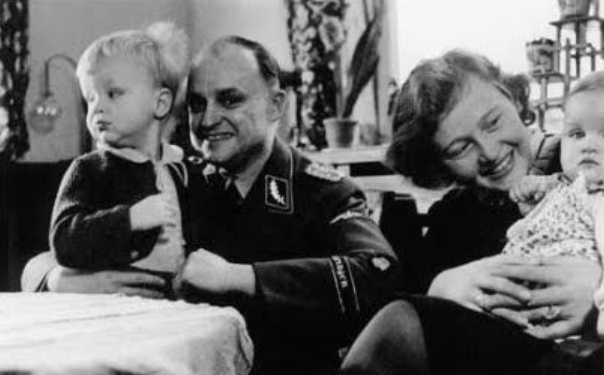
The League of German Girls taught young women to be independent, even encouraging them to rebel against their parents. Before this, it was unthinkable that girls would travel without parents, or do such previously male-oriented things such as camping and hiking. Many of these girls were barely in their teens and had little interest or understanding of politics.
Not all Nazi leadership approved of the organisation. Himmler once said, “When I see these girls marching around with their nicely packed backpacks, it’s enough to make me sick.”
The Bund Deutscher Mädel attempted to eradicate the influence of so-called decadent European fashion on German women. This idea did not start with the Third Reich, as there had been bad blood between the French and the Germans since the 1600s. The French considered Germans to be “a nation of fat, unrefined, badly dressed clowns”. The Nazis strove to divert the fashion of girls and women away from the post-First World War Garçonne-style, and the contemporary Parisian and Hollywood models, by offering them two primary templates: the farmer’s wife, in local folk attire, also known as the Trachtenkleidung or dirndl-fashion, including apron, embroidered collar and puffed sleeves; and the organisational modern German woman-in-uniform, with neat hair, away from the face (braids), armbands and badges. While boys were groomed primarily for the military, girls, although encouraged and trained for more supportive roles, with emphasis on mothering good Aryan children, inadvertently became exposed to many freedoms and career choices previously unavailable to them, including travel and opportunities for careers in medicine, security and administration.
German Empress Augusta Victoria of Schleswig-Holstein, Queen of Prussia by marriage to Wilhelm II, visited Bexhill twice around 1916. There were other Augusta-Victoria Schools for Girls. Marlene Dietrich and her older sister, Liesel, attended one in the Nürnbergstrasse, Berlin, between 1906 and 1918. At the outbreak of the Second World War, Dietrich renounced her German citizenship and became a US citizen.
All of the students in Six Minutes to Midnight were fictional characters but the story could have been richer if it had explored some of the Nazi backgrounds of the girls who actually attended the school. Christa Stumpff was the daughter of Luftwaffe general Hans-Jürgen Stumpff, one of the signatories to Germany’s unconditional surrender at the end of the war. Isa von Bergen was the daughter of Hitler’s representative at the Vatican, Diego von Bergen. He spoke at the funeral of Pope Pius XI in 1939.
Bettina von Ribbentrop was the daughter of Count Joachim von Ribbentrop, minister of foreign affairs of Nazi Germany. His wife, Anneliese von Ribbentrop, was a leading Nazi fashion celebrity. Ribbentrop was said to have been intimately involved with Wallis Simpson, the paramour of Edward VIII. As the German Ambassador to the UK, he was ordered by the Führer to flatter Wallis and become intimate with her as a means of keeping Edward VIII friendly to the Nazi regime. He sent her seventeen long-stemmed red roses daily, to remind her of the number of nights they had spent together. Ribbentrop was convicted and sentenced to death at the Nuremberg trials, becoming the first Nazi war criminal to be executed by hanging.
Princess Herzeleide Ina Marie Sophie Charlotte Else was the only daughter of Prince Oskar of Prussia, the fifth son of Wilhelm II and Empress Augusta Victoria. She was given the name Herzeleide, meaning heart’s sorrow.
Dagmar Westberg became heir to Beiersdorf AG. Her great-uncle, Oskar Troplowitz, was the inventor of Leukoplast wound treatment products, Coppertone and Nivea, the world’s largest skin care brand. After the war Westberg worked for many years at American consulates in Hamburg, Berlin and Frankfurt, becoming one of the most prominent patrons of Frankfurt’s Städel Museum. She lived to be 102.
Countess Reinhild Hardenberg was the sixteen-year-old niece of Ambassador Herr von Dirksen, the last German ambassador to Britain before the war. Her father, Count Carl Hans von Hardenberg, was a respected German soldier but opposed to the Nazis. Countess Hardenberg became engaged to Lieutenant Werner von Haeften, an aide to Colonel Stauffenberg, a member of the July 1944 plot to kill Hitler. When the plot failed, von Haeften was shot and killed and she was arrested by the Gestapo but released. Her father attempted suicide, failed and was sent to Sachsenhausen concentration camp. The camp was liberated the day before he was due to be executed.
Six Minutes to Midnight is very entertaining, beautiful to look at and offers a glimpse at a little-known anomaly in British and German war history. Stylistically, it skitters around somewhere between a serious historical-political thriller and an Agatha Christie-type period piece, falling a little short in each genre, which is due primarily to superficial writing and uncertain direction. I like Judi Dench, but this is not one of her most memorable roles. Izzard (in character below), while endearing, and a brilliant stage comedian, fails to convey the authenticity, or danger, of a classic field agent, in the manner of, say, a Bond, a Bourne or one of Le Carré’s flawed heroes. Billy Connolly is much more effective in this kind of serious drama, as evidenced by his role as Queen Victoria’s loyal servant John Brown in the 1997 film Mrs Brown.
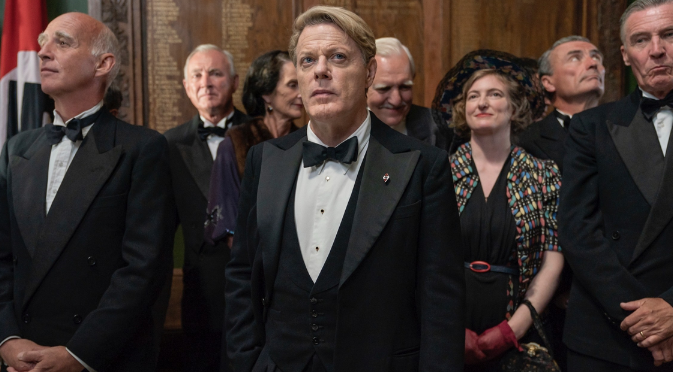
Although the idea for Six Minutes to Midnight was Izzard’s, a film he had “wanted to make for ten years”, the lead role of Miller would have been better served by an actor more experienced in sustained and understated dramatic tension, someone like Dirk Bogarde or Jamie Dornan. Izzard unwittingly becomes comic at inappropriate moments, such as the scene where he steals a band member’s over-sized uniform and is chased by police, which is almost Chaplinesque. There is also too much exaggerated cold glaring by James D’Arcy, as Captain Drey, recalling Arnold Schwarzenegger’s Terminator or Hugo Weaving’s Agent Smith in The Matrix.
The story has no romantic component and as far as secret-agent sex appeal goes, it’s all over the place, in much the same way as Izzard’s own sexuality is all over the place. For years, he has referred to himself as “genderfluid”, or has identified as a transvestite, and has variously described himself as “a lesbian trapped in a man’s body” and “a complete boy plus half-girl”. Izzard has recently asked to be referred to by the female pronouns she and her. For the purposes of this review, as Izzard is playing a male role, I am using male pronouns.
Bexhill-on-Sea, historically, has a reputation for conservatism and retirement. Spike Milligan was stationed there in 1940 and called it “the only cemetery above ground”. It also was a point of attack for Operation Sea Lion, the Nazi plan for invading Britain, although this isn’t covered in the film. During the war, Bexhill suffered fifty-one air raids, which killed twenty-two people and demolished seventy-four buildings.
In his book Secret Bexhill-on-Sea (2019), Alan Starr wrote that during the war, “Bexhill was a place that received evacuees. The Augusta-Victoria College was taken over as a convalescent home, but seems to have been used for housing difficult children.” Julian Porter said, “The College has always been a bit of a mystery in Bexhill … we know that the Baroness [von Korff] liked tennis and the girls spent a lot of time on the beach.”
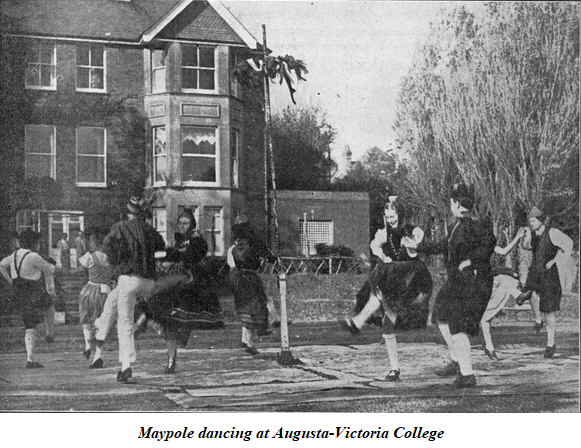
For a tiny coastal town, Bexhill has been home to quite a few unusual characters, including Izzard. Desmond Llewellyn, the original Q in the early James Bond films, lived in the old section. Bexhill resident David Hare wrote the play Plenty, made into a film starring Meryl Streep, and the screenplay for The Hours, with Nicole Kidman as Virginia Woolf. Starr said that “the celebrated leftist Hare seems to have left little mark on the town”. Bexhill resident Ella Ström married the eccentric Australian composer Percy Grainger. Restaurant critic and celebrity chef Fanny Cradock, and John Logie Baird, inventor of the television, retired there.
In my opinion, the writers of Six Minutes to Midnight had a real drama worth telling right in front of them and they missed it: the story from Molly Hickie’s point of view. Izzard had twenty-three pages of transcript and video footage of a conversation with her before she died. It was all there: the young naive English woman coming to work at Augusta-Victoria College, forming friendships with the German students, the real back-stories of the girls, including their parents, the League of German Girls, and a central love story between Molly and her German soldier fiancé, with its tragic ending. That’s where the “true story” worth telling really was, not in a fictional B-grade secret agent story.
Joe Dolce adds: Thanks to Julian Porter, curator of the Bexhill Museum
 Sign In
Sign In 0 Items (
0 Items ( Search
Search







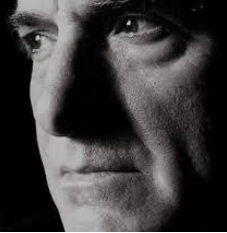


Thanks for the heads up. Although it was a pleasant read.
It sounds rather like a Biggles storyline. Still it raises several interesting questions. Firstly what would happen here in Australia in a modern war? Assuming the war lasted more than a couple of days, would foreign students of an enemy power be detained? Of course in lockdown Australia it might be impossible to tell detention from non-detention. Secondly, apart from secondary versus tertiary education, how do Confucius Institutes differ from the Augusta-Victoria College?
I have seen the film and it was the silliest I have seen for years. Such a pity as the story is interesting. Judi Dench is usually in much better movies
Yes, a very interesting story. Haven’t seen the film and from the sound of it I don’t much want to do so. But maybe I could dredge up some interest, simply for the period and the unusual set of circumstances. I am not such a big fan of Judy Dench, who plays Judy Dench in every part, so that might be another negative.